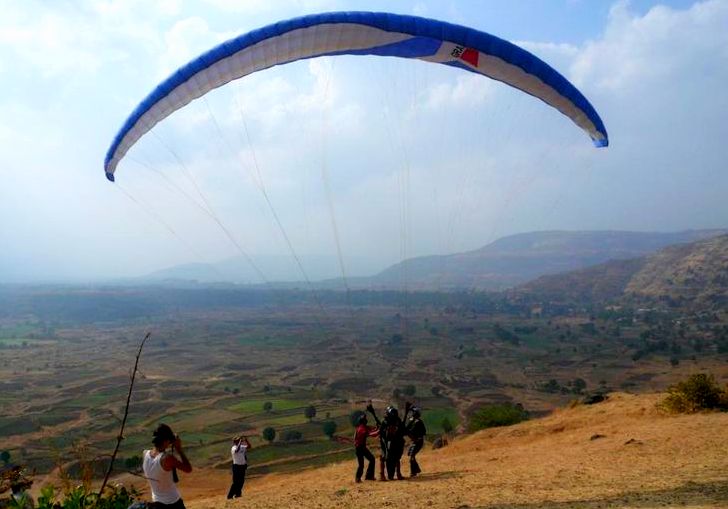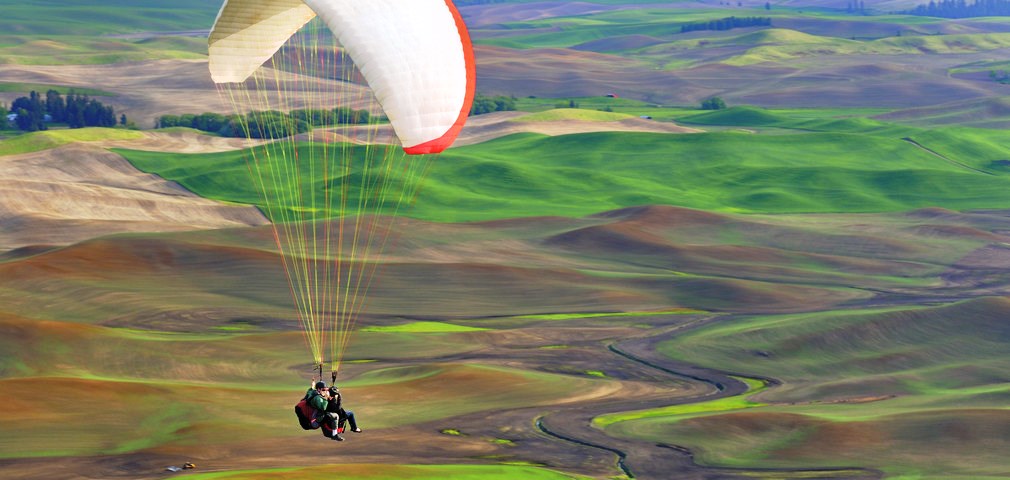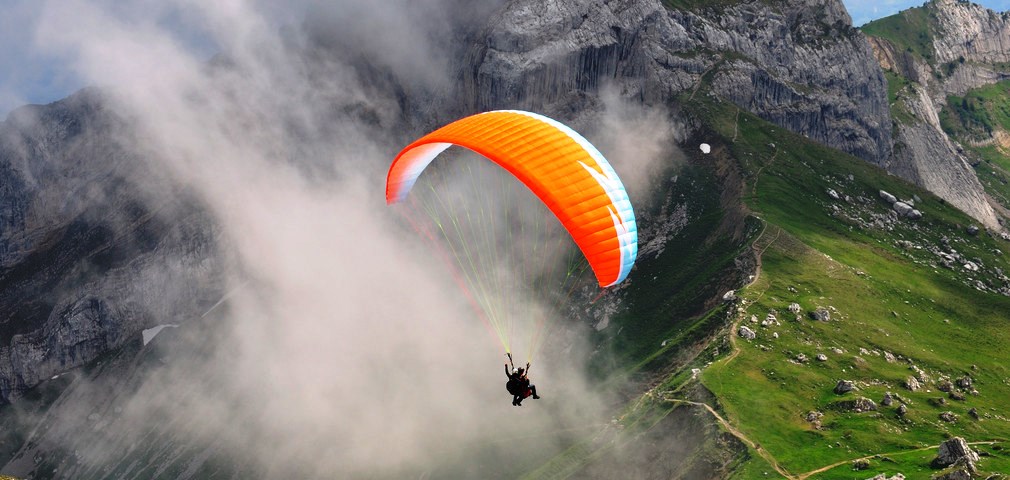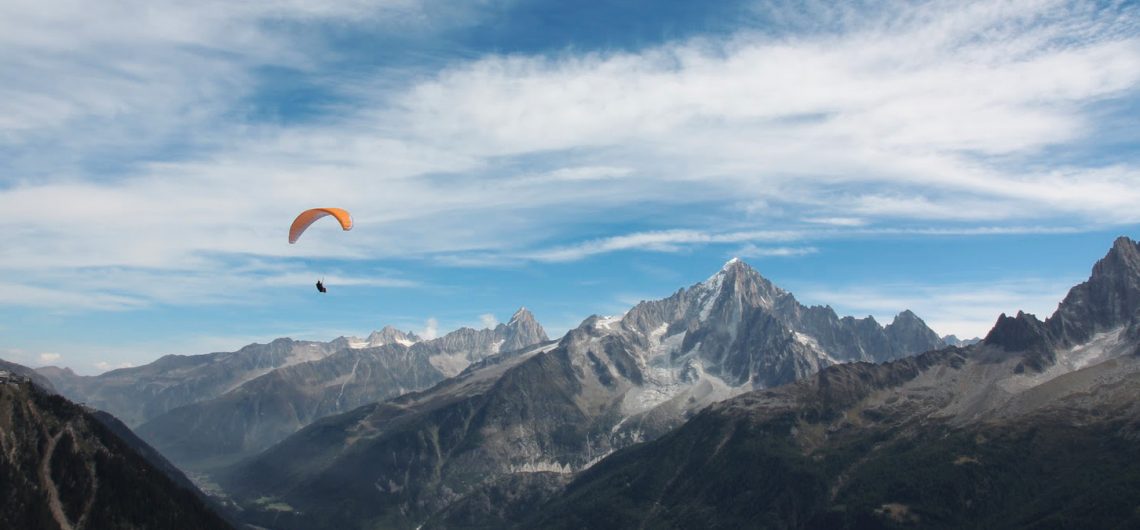Kartik
Latest posts by Kartik (see all)
- Taste The True Flavor of Ladakh On These Top Three Treks! - July 10, 2018
- Travel Goals: Why Kedarkantha Peak Is A Total Chase - May 18, 2018
- Spiritual Yatras 2018: Nanda Devi Yatra, Kailash Mansarovar Yatra - May 16, 2018
How many times have we seen birds soar across the sky, and thought to ourselves, “Man, wish I could fly like them.” And, during one such instance of thinking about flying, it struck me…I can actually do it. No, I wasn’t all of a sudden going to sprout wings and fly like a bird. But, what I was going to do was go for paragliding, and that is exactly what I did recently. Now, before I start telling you about my experience, let me just give you an overview of the activity.
What it is
Paragliding is simply flying in a small aircraft, called a glider, which does not have an engine. The glider’s main component is a wing, made of a lightweight but sturdy frame, around which two layers of fabrics with empty cells are stitched. The cells keep the wing naturally inflated while in flight. The harness, the seat you sit on, is fixed to the wing by strong ropes, called lines or risers (they control the wing). You are launched as the glider is placed in the wind’s direction and pulled or pushed. You control it by pulling on a number of strings that are connected to the wing.
How safe it is
Well, the first burning question, which comes to mind before indulging in it, is ,”How safe is it?”. The answer would be, quite. As per some researches, paragliding as an activity is even safer than say, driving or biking. This fact has been established by comparing the number of deaths that the latter have led to in the recent past. There is little danger of the glider collapsing as the equipment is designed with the latest technology. But, as with everything, it is not that injuries never happen. They do, and sometimes they might just turn ugly. If you do not observe proper caution, you may end up spraining or breaking your ankles or legs. This is the most common type of mishap associated with the adventure sport.
 The biggest reason injuries happen is that riders are not really covered; they are open; the feet hanging in the air and the hands holding the controls. This is why there is a chance you might get cuts or bruises on places other than your legs or hands. Another type of injury, and a real ugly one, can happen to your spine! Yikes…But, thankfully, modern gliders come equipped with back protectors. So, all in all, paragliding is a safe sport, which carries minimal chances of the participants getting hurt.
The biggest reason injuries happen is that riders are not really covered; they are open; the feet hanging in the air and the hands holding the controls. This is why there is a chance you might get cuts or bruises on places other than your legs or hands. Another type of injury, and a real ugly one, can happen to your spine! Yikes…But, thankfully, modern gliders come equipped with back protectors. So, all in all, paragliding is a safe sport, which carries minimal chances of the participants getting hurt.
My Story
Now that I have given you an overview of the sport, let me begin with my story. As is a prerequisite for the activity, you need to find an elevated spot to launch the glider. It immediately struck me that what better place to find such sites than the Himalayas. So, I began searching for places, where paragliding is organised and came across Bir Billing in Himachal Pradesh. Just Google the destination, and the first image would be of paragliding, indicating how popular the sport is here. At once, I wanted to go there for my first experience of paragliding, but I knew nothing about it! With a little more research on the internet, I came to know that many tour operators and agencies offer introductory paragliding courses, and I thought about enrolling myself into one because I certainly didn’t want to injure myself.
 The first thing the instructor told us (there were other participants as well) was how to assess the wind condition and state of the launching site. This was important as everyone should be absolutely sure if it is safe to fly. The next step was getting us acquainted with the glider and its various controls. Then, we were told about how to unpack the wing or canopy and connect it to the harness by ropes or lines. Further, came the essential pre-flight safety checks on the helmet, shoulder and leg straps, carabiners (hooks that secure you to the harness) and glider cords. Handling the equipment on the ground is the next lesson. It is important as you should be comfortable with the glider and be able to make a smooth launch. Later, we got our hands on the controls as the instructor taught us how to use them for changing the speed, direction and angle of attack.
The first thing the instructor told us (there were other participants as well) was how to assess the wind condition and state of the launching site. This was important as everyone should be absolutely sure if it is safe to fly. The next step was getting us acquainted with the glider and its various controls. Then, we were told about how to unpack the wing or canopy and connect it to the harness by ropes or lines. Further, came the essential pre-flight safety checks on the helmet, shoulder and leg straps, carabiners (hooks that secure you to the harness) and glider cords. Handling the equipment on the ground is the next lesson. It is important as you should be comfortable with the glider and be able to make a smooth launch. Later, we got our hands on the controls as the instructor taught us how to use them for changing the speed, direction and angle of attack.
 After that, we were explained the entire mechanism, which allows a paraglider to lift from the ground and fly. Remember to listen to this part carefully, as it will help you understand what to do in the air, better. When all this was done, came the moment I had been waiting for, getting strapped in the harness and launching! We were made to keep the canopy at exactly 90-degree angle to the wind direction and mould it into a horseshoe shape by pulling it, much like we do with a kite; this is why this technique is also called kiting. We then held the control lines or risers, connecting the harness to the wing. Further, we ran with the canopy in our hands. You must be fast enough to allow the air to enter the empty wing cells, causing lift. We were also told of the common mistakes people make during launching and how to avoid them.
After that, we were explained the entire mechanism, which allows a paraglider to lift from the ground and fly. Remember to listen to this part carefully, as it will help you understand what to do in the air, better. When all this was done, came the moment I had been waiting for, getting strapped in the harness and launching! We were made to keep the canopy at exactly 90-degree angle to the wind direction and mould it into a horseshoe shape by pulling it, much like we do with a kite; this is why this technique is also called kiting. We then held the control lines or risers, connecting the harness to the wing. Further, we ran with the canopy in our hands. You must be fast enough to allow the air to enter the empty wing cells, causing lift. We were also told of the common mistakes people make during launching and how to avoid them.
Then, the instructor hopped on the harness with us in tandem (it was our first time; they were not going to push us alone), we ran together and we finally flew! It was so amazing, seeing the green valley with fir trees below and snow-covered mountains all around. Seriously, I cannot tell you how it feels. You will have to do it to experience it. I guess the only reason my paragliding ride was so fruitful is that I took precautions by taking a course first. So, I suggest that you too enroll, if you have never done it before.
Precautions
Apart from enrolling in lessons, there are other precautions that can make your trip better. Let’s take a look at a few important ones.
- Age: As a general notion, paragliding is advised for people, who are 15 years of age or older. This age is just perfect for you to start, as by the time you turn 15, you would be strong enough to hold a glider and run with it. Your arms would have enough strength, needed to hold the glider and pull the control cords, and your feet strong enough to support your weight while landing.
- Weight: Most paragliding operators or tour agencies recommend weights between 20 kg and 115 kg. The idea is that you should neither be lighter than the equipment nor be so heavy that the gilder doesn’t lift off the ground. If you weigh too much, you might even end up crushing the harness (now, we wouldn’t want that, would we).
- Fear of Heights: One of the most important things to consider before flying is that you are not afraid of heights. How do you plan to fly if you can’t deal with being high? If you have a fear of heights, the slightest elevation gain can make your heart racing; this is different from when it happens due to the excitement. You may have a panic attack, which could seriously endanger your life.
- Pregnancy: If you are pregnant, then you cannot indulge in paragliding. The reason for the restriction is that if you get hurt, you might hurt your baby as well.
- Fitness: The good thing about paragliding is that no prior exercising is required. But, you must see that you don’t suffer from any condition like epilepsy, sudden fainting, hypertension, diabetes or giddiness. Also make sure that your knee and elbow joints are strong as your legs have to support your weight while landing and your arms have to be stretched during the entire flight.
- Attire and Accessories: Though most paragliding agents tell you that you can wear just about anything for a flight, there are still some minute things to keep in mind. The best attire for a ride would be track pants and a t-shirt, along with a jacket. Avoid wearing slippers as they could easily fall; you don’t want to ‘lose your shoe’. So, go for comfortable sports footwear, which can be easily fastened to the harness. You would also require sunglasses as when you fly, the sun will be right in your eyes. Sunscreen lotion is also an important thing because it will protect you from the harmful UV radiation.
So, there you go. These are some important things to know before you head out for paragliding. Though it does look like a cakewalk sometimes, you still want to be careful. Remember the saying, “Life is not a fairy tale. If you lose your shoe at midnight, you’re drunk”. Meaning that even a small accident could be cause for great worry as you might end up hurting yourself. So, take precautions, be careful and enjoy the ride of your life.



